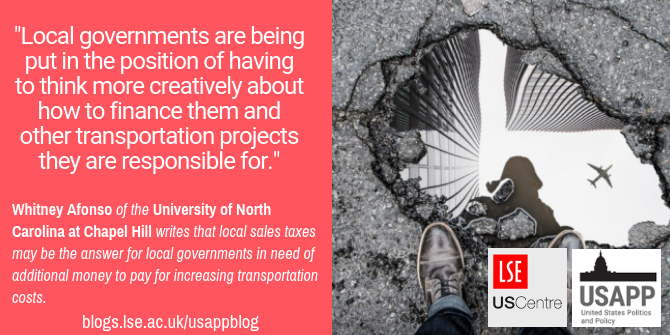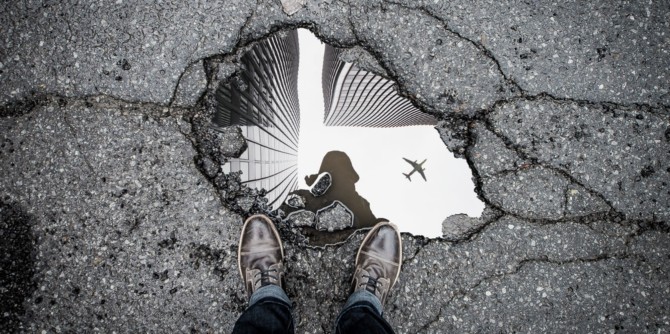 America’s infrastructure is frequently said to be in a sorry state, and the nation’s roads are no exception. Whitney Afonso points out that local governments are responsible for 3/4 of the country’s roadway miles. She argues that one way that counties and cities can fund road improvements is via introducing or increasing local sales taxes. There is good evidence, she writes, that these earmarked taxes do actually support road building and repair, but whether or not they are used often depends on the local jurisdiction and whether concerns about the equity of the tax can be overcome.
America’s infrastructure is frequently said to be in a sorry state, and the nation’s roads are no exception. Whitney Afonso points out that local governments are responsible for 3/4 of the country’s roadway miles. She argues that one way that counties and cities can fund road improvements is via introducing or increasing local sales taxes. There is good evidence, she writes, that these earmarked taxes do actually support road building and repair, but whether or not they are used often depends on the local jurisdiction and whether concerns about the equity of the tax can be overcome.
During his State of the Union speech in February, President Trump remarked that “Both parties should be able to unite for a great rebuilding of America’s crumbling infrastructure”. And while the Federal government does have a role in maintaining the country’s roads, rails, bridges, and tunnels, it’s worth remembering that local governments – including towns and cities – own or are responsible for more than 75 percent of the nation’s more than four million miles of roads.
Given their massive responsibility for the nation’s often decaying carriageways, local governments are being put in the position of having to think more creatively about how to finance them and other transportation projects they are responsible for. One solution for local governments to consider would be to increase local sales taxes – but concerns about equity might also have to be overcome.
Much of the cost of maintaining US roads are still financed by state and federal government; only 30 percent of the cost of roads nationally is borne by local governments. Intergovernmental transfers from higher levels to local government are funded primarily through motor fuel or gas taxes. Unfortunately, as the fuel tax has been generating less revenue for decades due to factors like more fuel efficient vehicles and fuel tax rates not keeping pace with inflation, the future of intergovernmental transfers is less certain. Thankfully, fuel taxes make up a very small percentage of local funding though which traditionally comes from the general fund via revenue instruments such as the property tax. Nonetheless the result is that local governments are having to consider less traditional ways to finance transportation like the greater use of tolls, public-private partnerships, and earmarked local sales taxes. My focus covers local sales taxes that are frequently earmarked for transportation. Earmarking here means that any revenue generated by the sales tax must be used for transportation projects as defined by the state or by the local government when the referendum was brought forward to the community.

Photo by Marc-Olivier Jodoin on Unsplash
Local sales taxes can be adopted, depending on the state, by the county, municipality, or some special districts. Currently 39 states have local sales taxes available, but many of those states have very restrictive rules about either the jurisdictions that can adopt them, the rates that can be imposed, or the ways that the revenue can be spent. Despite the restrictions, local sales taxes have become the second largest source of (own source) revenue at the local level. Not surprisingly, the research into local sales taxes has grown too—much of it studying whether relying more heavily increases the volatility of revenues for local governments or the reasons why some jurisdictions adopt sooner than others or how neighbors impact collections. There has been less research done on how earmarks impact expenditures though.
One of these exceptions studies California local sales taxes that are earmarked for transportation. The theory and literature surrounding the impact of such an earmark is mixed, some results and theories suggest that those monies will just be substituted for with general fund dollars and that expenditures on transportation won’t be increased much, whereas other theories and results show that those dollars will “stick” to transportation and be used to increase funding and that initial study found evidence that the earmarked revenue increases transportation spending. This is important because 15 states have local sales taxes that are earmarked for transportation and an additional 7 have local sales taxes that can be earmarked for specific areas including transportation.
Given that there is some evidence that local sales tax revenue earmarked for transportation is actually being used to increase transportation expenditures, are these local sales taxes a solution for local governments needing to find revenue to support their transportation projects and infrastructure? Maybe, and some of it likely depends on the characteristics of a jurisdiction.
The benefits of using local sales taxes to finance transportation
There are quite a few potential benefits to using local sales taxes as a way to finance local transportation. First, sales taxes have a very broad base. This means that a large amount of revenue can be generated at relatively low rates. Of course this is influenced by what all is included in the base. Many states exclude food items, prescription drugs, and services—which will lower the revenue generated. Second, while it is difficult to claim any tax is popular per se, sales taxes are more politically acceptable than many others such as income taxes. This is likely due to the fact that they are collected in small increments throughout the year unlike property taxes. Third, and perhaps most importantly for more populous or tourism-rich communities, is that local sales taxes allow local governments to capture revenue from non-residents. These non-residents (such as commuters, tourists, and college students) use services but do not pay for them through traditional means like property taxes and utility fees. In the case of transportation, this point is especially important because non-residents visiting a community are likely taking advantage of transportation infrastructure and services and while fuel taxes may capture revenue from them, other earmarked taxes like vehicle licensing fees will not.
Concerns over the use of local sales taxes to finance transportation
Most concerns regarding the use of local sales taxes for transportation are either related to equity or stability. Sales taxes are regressive which means that less affluent people will pay a higher percentage of their income in sales taxes than wealthier people. Additionally, many examine equity also through the connection between who pays for a service and who benefits from it. While a reasonable argument can be made that everyone benefits from good transportation infrastructure, the linkage between transportation and local sales taxes is not as strong as through a revenue instrument like a fuel tax or a toll. Lastly, there are concerns around both temporal and spatial equity. Many local sales tax referendums (especially those explicitly earmarked) are likely to have the future plans of how the local sales tax revenue will be spent and invested. While this can increase accountability and transparency it may also lock in sub-optimal priorities because it is difficult to know and predict the changing needs of a community. Local sales tax dollars will be collected throughout the community, but not all areas may be equally served by transportation projects they fund. The concerns around stability revolve around the fact that sales taxes are volatile, especially those with smaller tax bases due to food being excluded which is the case in 32 states.
All of this is impacted by what the states actually permit, which is why it is critical to look into the laws of the respective states. Furthermore it is important to evaluate what other factors, outside legal constraints, may impact revenue generation such as the number of non-residents that typically visit a jurisdiction, what is include in the tax base, who your neighbors are and whether their rates are low enough that increasing your rates may encourage people to do their shopping in another jurisdiction, amongst others. Despite the concerns and the nuance, local sales taxes are being used increasingly to finance local government and one of the most common earmarks for local sales tax revenue is on transportation.
- *This article highlights key results of the chapter “Financing Transportation Through Local Sales Taxes” by Whitney Afonso. The chapter was published in ‘Building a Sustainable Transportation Infrastructure for Long-term Economic Growth’, edited by Olga Smirnova.
Please read our comments policy before commenting.
Note: This article gives the views of the author, and not the position of USAPP – American Politics and Policy, nor of the London School of Economics.
Shortened URL for this post: http://bit.ly/2JcUvOp
About the author
 Whitney Afonso – University of North Carolina at Chapel Hill
Whitney Afonso – University of North Carolina at Chapel Hill
Dr. Whitney Afonso is an Associate Professor at the School of Government at the University of North Carolina at Chapel Hill. Her research focuses on state and local public finance and has been published or is forthcoming in journals such as Public Budgeting & Finance, Public Finance Review, Public Administration Review, Journal of Public Policy, State and Local Government Review, and Contemporary Economic Policy. Her article, “Leviathan or Flypaper: Earmarked Local Sales Taxes for Transportation,” received the Burkhead Award for best article published in Public Budgeting & Finance in 2015. Afonso earned a BA in political science from Vanderbilt University, and an MA in economics and PhD in public administration and policy from the University of Georgia.




